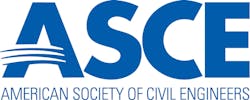ASCE Headquarters Parking Lot Renovation Serves as Stormwater Management Demonstration Project
RESTON, Va. – The American Society of Civil Engineers Foundation today unveiled a newly renovated ASCE Global Headquarters parking lot, which will serve as a green infrastructure demonstration project for the Northern Virginia region. It was renovated using low-impact development (LID) practices to reduce stormwater runoff and to improve stormwater quality discharged to the watershed. Features include 6,000 square feet of permeable interlocking pavers; a courtyard area with engraved pavers, and stormwater management system; a Filterra® unit and Stormcrete® precast porous concrete parking spaces and walkways.
Much of the parking lot surface will be milled and repaved with asphalt containing recycled materials for increased strength and durability, donated to ASCE by Asphalt Plus. The mix contained about 622 scrap tires which represent about four years of tires for 155 employees.
“This project is an example of ASCE walking the talk on sustainable infrastructure,” said Tom Smith, ASCE Executive Director. “Our parking lot was in need of significant repair and repaving, so ASCE seized the opportunity to use this project to enhance the environment by improving the quality and reducing the quantity of stormwater runoff, while at the same time providing a showcase for sustainable practices and an outdoor educational tool for members and visitors. Thanks to the vision and efforts of staff and volunteers, this project will contribute to the health of the Chesapeake Bay and enhance the aesthetic and functional appeal of our property. We’re also grateful for the generosity of numerous engineering firms, contractors, suppliers and members who made this project possible through their contributions."
The project also incorporated ASCE’s own technical guidance and engineering standards during construction, such as ASCE 68-18 Permeable Interlocking Concrete Pavement, which provides design, construction and maintenance guidance for permeable interlocking concrete pavement to achieve stormwater management goals while providing a structurally adequate pavement section to accommodate the anticipated vehicular loading in a cost-efficient manner. The Society develops and encourages use of consensus-based standards in construction, serving as a reference for structural design requirements in U.S. building codes to ensure infrastructure is resilient, sustainable, reliable and safe.
Several features of the parking lot include:
Stormcrete® modular precast porous concrete slabs – during a storm, runoff flows over pavement, picking up pollutants such as dirt, grease and oil. These contaminants are then washed into to streams and storm sewer systems. Porous concrete allows water to drain through the concrete and the underlying stone bed and reduces the number of pollutants from entering storm drains or waterways.
Focalpoint Biofiltration System –Stormwater runoff from urban areas often contains many types of pollutants, including sediment, oil and grease, chemicals, pesticides, heavy metals, bacteria, viruses and oxygen-demanding compounds. Water biofiltration improves water quality using living material to capture, absorb, consume or biologically transform these pollutants.
Filterra System – with pollutants in stormwater runoff, stormwater is filtered through a mulch layer, capturing heavy sediment and debris. The mulch layer also helps retain water for the system’s vegetation. Designs like this Filterra system provide a Low Impact Development (LID) solution for tight, highly developed sites, such as commercial parking lots, residential streets and streetscapes. Its small footprint also reduces installation and life-cycle costs versus traditional bioretention methods.
Permeable Paver Area – As cities and suburbs become larger and densely populated, sidewalks, parking lots and roads have replaced natural vegetation. These impervious surfaces dramatically increase stormwater runoff and pollution resulting in streambank erosion, flooding and water quality degradation. As a LID tool, permeable interlocking concrete pavement allows runoff to infiltrate into its joints, then stores and filters stormwater through aggregate in the bedding, base and subbase before returning to the soil. This innovative permeable pavement greatly reduces runoff volumes and water pollution while recharging groundwater aquifers. In addition, stress and damage to the existing drainage infrastructure are reduced as well as local flooding.
Pavement with recycled additive (Dry Process Rubberized Asphalt) – an alternative to traditional road paving material, this type of asphalt helps to extend pavement life and is made by blending finely ground scrap tires into an asphalt mixer. Benefits include cost savings, safety and noise reduction.
The six-story building that houses ASCE Global Headquarters is owned by the ASCE Foundation and has been home to ASCE since 1994. It hosts several thousand visiting engineer members of ASCE each year has also been LEED and EnergyStar certified since 2013.












